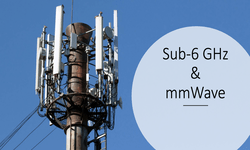NGAP – NG Application Protocol over N2 Interface
NGAP Protocol over N2 Interface
In the 5G SA, NG interface is designed to interconnect gNB and 5G Core which is similar to S1 interface in 4G LTE connects eNB and EPC. Considering Control and user plane separation specification has defined NG interface as NG-C and NG-U. NG-C allows signaling between a gNB and an AMF and NG-U allows the transfer of application data between a gNB and a UPF.

In gNB split architecture, these NG interfaces connect the CU to the 5G Core Network. NG-C connects the CU-CP to one or more AMF, where as NG-U connects the CU-UP to one or more UPF. NG-C also called as N2 and NG-U called as N3 as per Reference Point Architecture and NG-C use NGAP protocol and NG-U use GTP-U protocol. In this post, we will discuss about NGAP Protocol.
NGAP Protocol Pointer:
- The protocol name NGAP is derived from the interface name NG with the addition of Application Protocol
- NGAP supports all mechanisms requires to manage the procedures between gNB and AMF
- NGAP also supports transparent transport for NAS procedures that are executed between the UE and the AMF
- NGAP does not have any version negotiation, it support forward and backwards compatibility of the protocol by a mechanism where all current and future messages, and IEs or groups of related IEs, include ID and criticality fields that are coded in a standard format that will not be changed in the future
- NGAP is applicable both to 3GPP access and non-3GPP accesses integrated with 5GC
- NGAP relies on a reliable transport mechanism and is designed to run on top of SCTP
- The key difference between NGAP and S1AP is that S1AP was designed only for 3GPP access (E-UTRAN) and not non-3GPP accesses
- NGAP is applicable to any access and defined in 3GPP TS 38.413 specification. Support for specific parameters related to non-3GPP accesses have been added to the protocol when needed
- N2 interface between gNB and AMF performs management functions, for example NG Setup, Reset, Error Indication, and Load Balancing
- NGAP supports Initial UE Context Setup functionality for establishment of an initial UE context at gNB
- NGAP Provides the UE capability information to the AMF during UE capability exchange
- It also support PDU Session Setup, modification, and release for user plane resources
- Paging over NGAP, providing the functionality to page UE within 5GC
- NGAP allows Trace of active UEs.
- UE location reporting and positioning protocol support.
- NGAP supports Warning message transmission for emergency services
Types of Services over NGAP Protocol
The signaling over NGAP provides following two types of services:
- Non UE-associated Service: These NGAP services are related to N2 interface instance between the gNB and AMF and used to establish the NGAP signaling connection between gNB and AMF, handle some overload situations and to exchange gNB and AMF configuration data
- UE-associated services: These NGAP services are related to a UE and involves signaling related to procedures where a UE activity is involved, e.g. at Registration, PDU Session Establishment, Deregistration etc.
Types of NGAP Procedures
An Elementary Procedure is a sequence of interaction between the gNB and AMF and 3GPP specifications has defined two types of elementary procedure.
- Request Response Procedure: In this types of procedures, the initiator gets a response from the receiver of the request, indicating whether the request was successfully handled or not or a failure response.
- No Response Procedures: These elementary procedures without does not expect a response from the receiver. These messages are used, e.g., when AMF wants to only deliver a downlink NAS message. There is no need for gNB to provide a response in that case since error handling is handled on NAS level.
Some elementary procedures are specifically related to only Non UE-associated services e.g. NG Setup Request/Response while others are related to only UE-associated services e.g., PDU Session Establishment. Even, there are some elementary procedures may be using either Non UE-associated or UE-associated signaling depending on the scope and the context, e.g. Error Indication procedure that uses UE-associated signaling if the error was related to a reception of a UE-associated signaling message, while it uses Non UE-associated signaling otherwise.
Request Response Procedure:

No Response Procedures:

NGAP Signaling for UE Registration

References:
- 3GPP TS 38.401 5G; NG-RAN; Architecture Description
- 3GPP TS 38.413: 5G NG-RAN, NG Application Protocol (NGAP)
- 3GPP TS 23.502 – 5G Procedures for the 5G System Release 15
Related Posts:
- Open Midhaul F1 Interface F1-C and F1-U
- 5G Standalone Mode Registration-Attach Call Flow
- 5G RAN and 5GC Network Slice Signaling
- 5G NR HO Setup: Handover Testing in Cabled Setup



